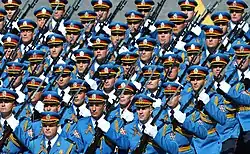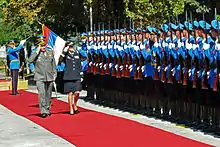Serbian Guards Unit
The Serbian Guard is an honor guard unit of the Serbian Armed Forces. It is a full-time regiment that is a directly reporting unit of the Serbian General Staff. The regiment is composed of 4 Battalions and 2 independent companies, all of which are based in the national capital, Belgrade. The guards take part in various events, such as arrival ceremonies at the Palace of Serbia and guard duty at Novi dvor (the seat of the President of Serbia).
| Serbian Guard | |
|---|---|
| Гарда Војске Србије Garda Vojske Srbije | |
 Serbian Guards in the 2015 Moscow Victory Day Parade. | |
| Active | 1830–present |
| Country | |
| Allegiance | |
| Branch | |
| Type | Honor Guard |
| Size | 4 Battalions, 2 independent companies |
| Part of | |
| Headquarters | Belgrade |
| March | Paradni Mars (Парадни Марш) |
| Engagements | Battle of Vukovar Balkans theatre of World War I |
| Commanders | |
| Chief of Staff | Major General Milomir Todorović |
| Guard Sergeant Major | Warrant officer 1st class Miroslav Marjanović |
| Insignia | |
| Ceremonial Flag | .gif) |
History
The Serbian Guard was formed in 6 May 1830 by the order of Prince Miloš Obrenović. It originated with 73 people selected for service in the Guard. On May 12, 1838, the Guard gained legal status from a special decree of Prince Miloš. In 1883, the Guard was transformed into a Royal Guard. The Royal Serbian Guard was considered to be an elite unit of the Royal Serbian Army and only the best conscripts were chosen to serve in its ranks. In 1914 the Royal Guard numbered a few thousand men and took part in all major battles of the Balkans theatre of World War I. The Royal Guard was commanded by Lieutenant-Colonel Nikola Kalabić during World War II and saw service against both Axis powers, their collaborators and the Yugoslav Partisans. On November 1, 1944, the members of the Royal Guard were absorbed into the Yugoslav People's Army (JNA). During the breakup of Yugoslavia in 1991, the Guard took part in the Battle of Vukovar and in the battles in Eastern Slavonia. It played an important role in these events, becoming a strike force for the JNA. The Serbian Guard in its current form was formed on November 30, 2006.[1]
Structure
- Headquarters Company
- Command Battalion
- Honor Guard Battalion
- 25th Military Police Battalion
- Supply Battalion
- Special Purpose Company
- Independent Honor Guard Drill Company
- Guards Band
Honor Guard Battalion
Since 28 July 2013, the guard has continued the renewed the tradition of an honour guard in front of the General Secretariat of the President of the Republic at Andricev Venac.[2] Battalion members took part both in the 2015 and 2020 Moscow Victory Day Parades. In the latter, the contingent under the command of Lieutenant Colonel Dragan Jakovljević, was lauded by Serbian President Aleksandar Vucic, describing as "a special feeling".[3]
25th Military Police Battalion
The 25th Military Police Battalion (Serbian: 25. батаљон војне полиције) is the military police unit of the guard and the Serbian capital. The motorcycles it uses for traffic regulation are produced by BMW. The main purpose of these motorcycles is escort riding, personal escort, regulation and control of traffic, both military and road.[4][5]
Independent Honor Guard Drill Company
The company took part in the finales of the Belgrade Military Parade in 2014 and the Defence of Freedom in 2019.
Guards Band
The Serbian Guards Unit Band is the official representative brass band of the unit and the larger Serbian Army. It is a descendant of the Serbian Prince’s Band in the 1830s. Stanislav Binički was a notable member of the band in the 19th century. He wrote common marches such as the Gardiski marš, Marš na Drinu and the Paradni Marš. It does not perform the traditional high step and (before 1975, the goose step) when marching on parade.
Gallery

 The Honor Guard Battalion
The Honor Guard Battalion The drill team
The drill team
.jpg.webp) During the 2014 Belgrade Liberation Day Parade.
During the 2014 Belgrade Liberation Day Parade._-_0014.JPG.webp) Guardsmen at Novi dvor
Guardsmen at Novi dvor.jpg.webp) A female guard
A female guard The salute battalion.
The salute battalion.
References
- sisteme, Vojska Srbije | Serbian Armed Forces :: Centar za komandno-informacione. "Војска Србије | Организација | Јединице Генералштаба Војске Србије | Гарда". www.vs.rs. Retrieved 2017-11-11.
- http://www.vs.rs/en/article/3F10E28FED9611E4ABAB00163E135070/the-honour-guard
- https://tass.com/world/1171283/amp
- http://www.bog-rata.com/2019/02/04/garda-srbija-motocikli-bmw/
- http://www.paluba.info/smf/index.php?topic=398.0;wap2